Executive summary
The Tasmanian forest industry refers to an association that is aimed at the conservation of Tasmanian forest. It achieves this by ensuring that the members of the surrounding community benefit from it. This report looks at the importance of this association to Australia in general and to the members of the communities living in the region where the forest is located.
The report analyses the performance of the associations and gives the future prospects of the Tasmanian Forest industries. Recommendations on the way forward in solving the problems that arise and affect the organisation’s operations are provided in the end.
The report shows how the government is participating to support these associations and the approaches it employs in ensuring that this project is highly beneficial to the Australian community. It also analyses the effects of the government regulation on the demand and supply of forestry products as well as looks at its impacts on the producers and consumers.
Background
The Tasmanian forest industry was developed under the Tasmanian Intergovernmental Agreement of 2011. This agreement was aimed at supporting the forest industry to progressively develop more sustainability and diversity. The agreement was also focused on building regional diversification and community resilience.
The agreement that brought this organisation into being was signed by the then prime minister Julia Gillard. The Tasmanian Intergovernmental Agreement was aimed at providing certainty for the Tasmania’s forest industry. It also targeted at supporting local jobs and communities as well as creating awareness on the need to value forests and forest products.
The Tasmanian government assists forest companies in Australia as well as in other parts of the world. It helps them adapt to the forest changes. It also protects communities and families which rely on the forest industries for survival. For instance, the government contributed funds in an agreement to help the victims affected by sudden changes in the forests.
This capital was directed towards such achievements as offering support to forest workers, contractors as well as their families, who got affected by the downturn in the forest industry. This is well confirmed by the incident where the Guns Limited Industry decided to quit native forest harvesting in the region. Many people who depended on the company were affected significantly.
These included the aforementioned victims (workers, contractors and their families). Several appropriate measures were employed to curb the challenges experienced during this incident. For instance, some of the cash contributed to tackle the issue was directed towards the implementation of a plan. A part of the other funds was directed for creating new forest reserves that were to be established.
In other words, appropriate measures were integrated to help curb the situation faced by workers, contractors and families associated with the Guns Company. From this scenario, it can be learned that the principle statement of this association is to recognise the importance of building on an essential advancement that was established during the first round negotiations.
At the same time, there is a need to offer a full resolution to the holistic agreement with respect to the forest industry development with effective support and facilitation from the Tasmanian and Australian government (Tasmanian government, n.d.).
Currently, the Tasmanian Forest Industry proves to offer many benefits through its support of the Tasmanian people (Tasmanian government, n.d). In jobs and growth funding, the government of Australia has continuously supported the Tasmanian forest organisation by promoting the economic diversification. The Tasmanian industry has offered employment to a large number of Australian citizens.
This association also encourages training and transfer of potential workers and contractors from one location to another. This has enabled the forest workers to work in locations of their own choices. Furthermore, training they are provided with makes them more competent.
Lastly, the organisation is concerned with the wellbeing of the personnel as well as the entire community. This is evident from the fact that it offers counselling activities to the members of the society. The counselling services offered by the Tasmanian association include mental health counselling, suicide prevention and community wellbeing assistance.
These services are available to all forest workers, their families and business associates as well as the members of the communities that have been affected by the recent changes taking place in Tasmania (Dessaix, 2004).
Government policy
The government has many effects on the operation of any business. It regulates the operations of a business through its legislation. It formulates and implements policies which organisations must adhere to, both in internal and external operations.
In this context, a policy refers to the guidelines of operation that have been proposed by the government, which the Tasmanian Forestry Industry must observe. Some of the policies affecting the operation of the Tasmanian Company include tariffs and subsidies which are imposed by the government (Fernando, 2011).
Tariffs
Government interventions in the market can have far reaching results (Baye, 2009). There are different government interventions that can modify market demand and supply. Examples of such intervention are taxes, tariffs, subsidies and quotas (Baye, 2009).
A tariff is an indirect tax imposed by a government on imported goods. Tariffs are designed to protect specific domestic industries from foreign competition in the market.
Supposing the government imposes tariffs on imported timber, it will have two major effects on the Tasmanian timber market. The price of Tasmanian timber (new price P1) will rise to a point where it is equal to the pre-tariff price plus the new tariff because the foreign suppliers of timber will be restricted by being instructed to pay more if they want to trade their products in the market.
Considering the fact that the foreign timber suppliers are restricted by paying tariffs, this will cause an increase in the demand for domestic timber, causing a rightward shift in the demand curve (Arnold, 2013). The total amount of timber purchased by Tasmania consumers falls from Q0 to Q1. The graph below illustrates these effects.
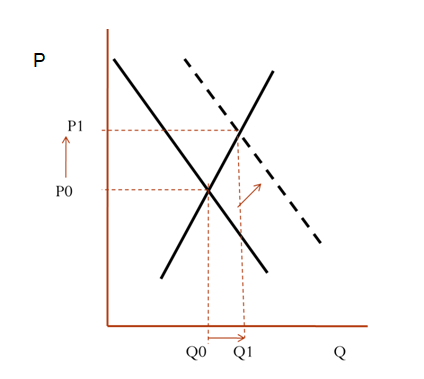
On the supply side, the tariff will cause a decrease in timber supply in the market, leading to a leftward shift in the supply curve because in the first place, the supply of timber in the market was high as both the domestic and foreign suppliers accessed the market without barriers. The domestic supply minus the foreign supply will, however, lead to reduced timber supply.
The tariffs imposed on the foreign suppliers will deny them previous benefits, and therefore, they will be forced to get out of the market. The domestic suppliers will gain a competitive advantage after the tariffs are imposed.
Their supply in the market will, however, be low compared to the supply of timber by domestic and foreign suppliers combined. The quantity supplied will decrease from Q0 to Q1 and will sell at the price P1. The graph below illustrates the supply-side effects of the tariff.
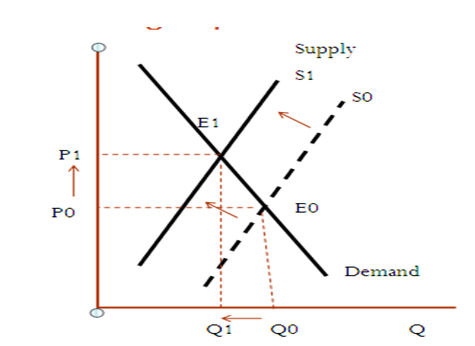
From the above illustration, it is evident that Tasmania producers will benefit at the expense of consumers. There is an increase in the demand for domestic timber at a higher price than the pre-tariff price. On the other hand, consumers lose due to the subsidy which leads to high prices of domestic timber.
Demand and supply curve are linear and show the demand and supply of goods and services at a given price. The new price due to the tariffs imposed may cause a movement along the demand and supply curve, rather than shift. The graph below illustrates this scenario.
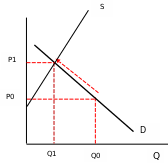
On the demand side, the tariff can cause the movement of the supply curve. The graph below illustrates this scenario.
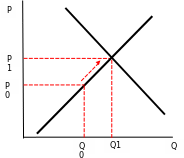
The Australian government imposes the tariffs to protect the Tasmanian timber industry. This tariff limits the importation of non-Tasmanian timber and thus relieves the timber industry. In the end, the Tasmanian timber market can gain efficiency. The consumers do not, however, benefit from this move.
Subsidies
Supposing the government subsidizes Tasmania timber producers, the supply curve will shift rightwards. This reduces the prices paid by consumers and increases revenues received by timber producers. Similarly, the subsidy shifts the demand curve rightwards. This reduces the equilibrium prices, meaning that timber consumers receive lower prices. On the same note, producers receive the same amount of subsidy.
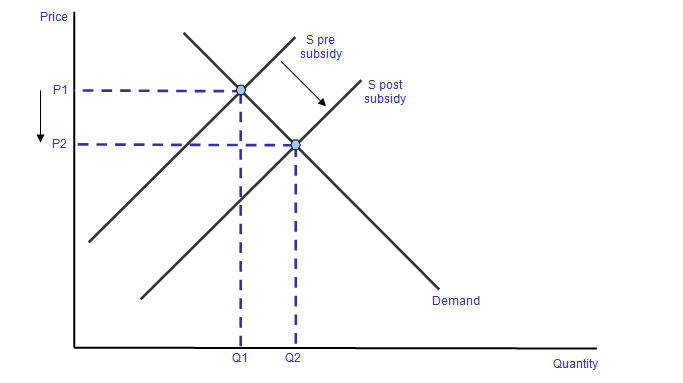
The elasticity of demand and supply will determine who gains more from the elasticity. Consumers will gain more if the demand curve is more inelastic and vice versa. On the hand, if the demand is elastic, producers will gain more than consumers. This is illustrated in the following graph.
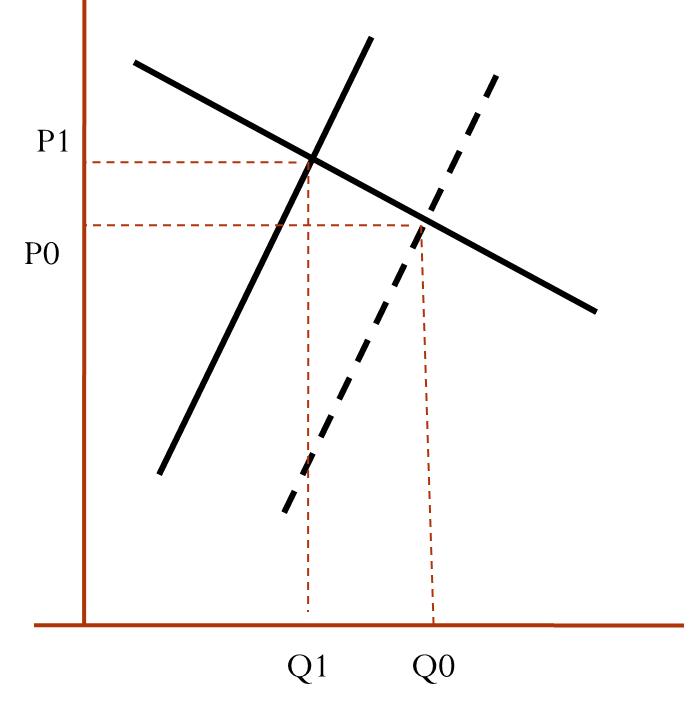
The introduction of subsidy is premised on protecting the consumers from high prices of timber. In addition, the subsidy is also meant to guarantee minimum prices that timber producers can set. Finally, it can be hypothesised that the government intends to cut losses in Tasmanian timber industry.
Market trends of timber
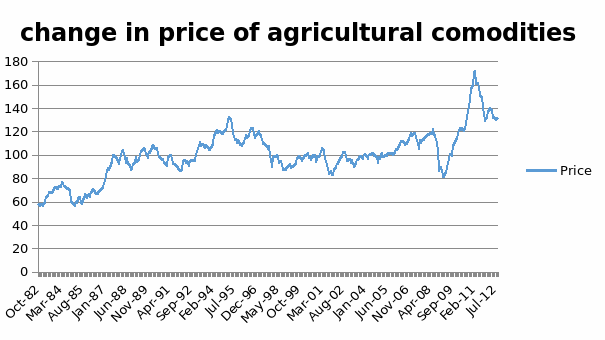
The change in the price of agricultural products, as shown by the above diagram, shows that the price of agricultural products has been fluctuating since October 1982, however, most of the time, the price of the products is low.
In October 2009, the price of the products is very high, and this shows that the producers benefited greatly. This, however, was a disadvantage to the consumers because they were accessing the products at a higher price.
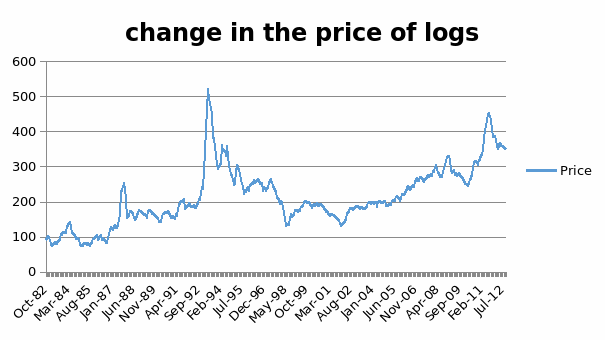
From the graph, it is evident that it is in 1995 when the price of logs was very high in the region. The price of products was fluctuating from one year to another, and this can be attributed to various factors, such as weather and environmental degradation that might have lowered the production of trees, thus making the price get high (Lockwood, Loomis & DeLacy,1993).
In 2012, the price of the products rises again, and this is attributed to the government policies that prevented the importation of timber from outside the state.
Future prospect of Tasmanian industry
This organisation has continuously brought benefits to the community of Tasmania. The activities of this association have led to the development of the region because of various factors. The industry is providing the community with various services, thus raising the living conditions of the people in the region.
This industry has provided the members of the community with a lot of employment possibilities, thus positively impacting the GDP of the country. The operation of the organisation will enable the country to conserve the environment for future sustainability.
Environmental sustainability will be attained because the industry will have the obligation to conserve forests to enable them to get timber which is their main trading product (Lindenmayer & Hobbs, 2004). It is anticipated that the industry will lead to the improvement in the technology being used in protecting and taking care of the forests in the region.
This will be achieved through upgrading harvesting equipment and introducing new equipment management in the region. In addition to this, there have been attempts by this organisation to develop their own source of energy from timber waste products, thus conserving the non-renewable source of energy (Lindenmayer & Hobbs, 2004).
There are some structural changes that are happening in this forestry industry. This is a result of shifts in the supply and demand conditions resulting from internal and external factors. The external factors include the appreciation of the Australian dollar and the contraction of the Japanese market.
The contraction of the Japanese market is a result of Japanese individuals preferring the wood from their plantation forests to those of the Australian ones. Owing to this, the percentage of share that Australia has in Japan has reduced by an average of 35% (Hall & McArthur, 1993).
The operation of the forest industry in Tasmania is likely to be affected if the government approves the legislative measures from the agreement between various forest industries groups and environmental groups that are arising from the Tasmania forest industry statement (Lockwood, Loomis & DeLacy, 1993).
This will result in significant changes of the Tasmania forest organisation with the main one being a decline in the forest activities that will lead to the reduction of jobs as well as products from the industries. Global change is another factor that is the ongoing concern of these industries. This is from the fact that there have been changes in the world that are threatening the ecological system of the Universe (Dwivedi, 2006).
Global warming and environmental degradation may result in a situation whereby the forest industry will not be growing, thus not employing a lot of individuals from the Tasmania community.
That is why it is important for the Tasmanian industries to venture into the conservation of the environment with the aim of ensuring that there is a sustainable supply of products from the forest. This will also ensure that there is a mechanism for the environment to absorb the waste products that are being released to the environment (Hall & McArthur, 1993).
List of References
Arnold, R. A. 2013, Microeconomics (Arnold), Cengage Learning, Stamford, CT.
Baye, M. R. 2009, Managerial economics and business strategy, McGraw-Hill Irwin, Boston.
Dessaix, R. 2004, The best Australian essays 2004, Black Inc., Melbourne.
Dwivedi, D. N., 2006, Microeconomics: Theory and applications, Pearson Education, New Delhi.
Fernando, A. C. 2011, Business environment, Pearson, New Delhi.
Hall, C. M., & McArthur, S. 1993, “Ecotourism in Antarctica and adjacent sub-Antarctic islands: development, impacts, management and prospects for the future,” Tourism Management, vol. 14, no. 2, pp. 117-122.
Lindenmayer, D. B., & Hobbs, R. J. 2004, “Fauna conservation in Australian plantation forests–a review,” Biological Conservation, vol. 119 no. 2, pp. 151-168.
Lockwood, M., Loomis, J., & DeLacy, T. 1993, “A contingent valuation survey and benefit-cost analysis of forest preservation in East Gippsland, Australia,” Journal of Environmental Management, vol. 38 no. 3, pp. 233-243.
Tasmanian government n.d., Tasmanian forests agreement. Web.
Taylor, J. B. 2007, Principles of microeconomics, Houghton Mifflin, Boston.